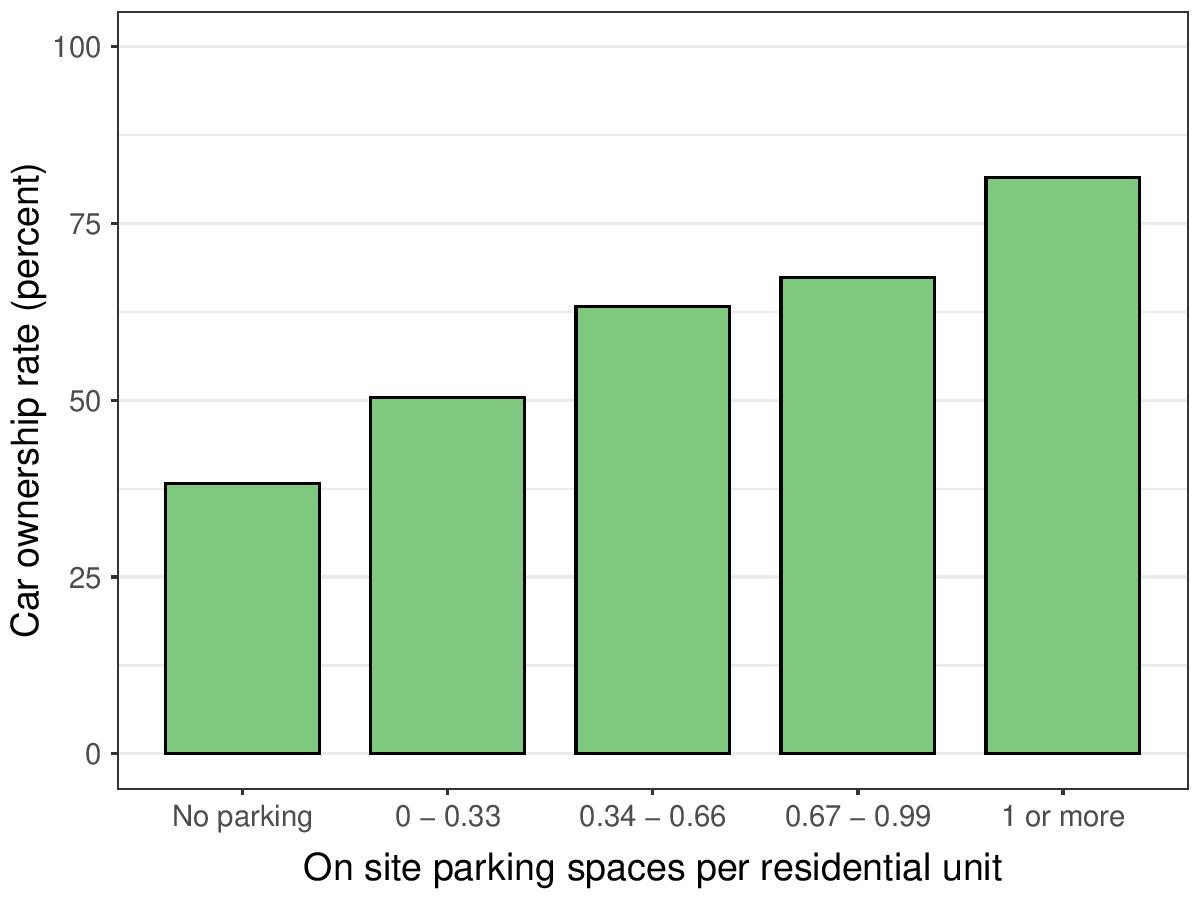Residential Parking Supply Has a Stronger Influence on Household Travel Choices Relative to a Neighbourhood’s Walkability and Access to Transit
Blog post by Adam Millard-Ball and Jeremy West
- Created
- 15 Mar 2021, 5:01 p.m.
- Author
- Adam Millard-Ball, Jeremy West
- DOI
- 10.1177/0042098021995139
Abstract: https://journals.sagepub.com/doi/full/10.1177/0042098021995139#abstract
Issue
A large volume of research suggests that neighbourhood attributes such as public transportation access, residential density, and walkability can have important impacts on people’s travel, carbon footprint, and employment opportunities. More often than not, however, the research conducted on this topic is subject to “self-selection bias.” For example, people who prefer to walk and ride transit are likely to move to neighbourhoods that support these choices, while those who prefer to drive instead move to places with nearby highway access and ample parking. To overcome these biases, a research team at the University of California, Santa Cruz surveyed successful applicants to San Francisco’s affordable housing lotteries about their transportation choices and employment. In San Francisco, nearly all new housing developments with ten or more residential units must provide affordable housing units at below-market rates. The units are normally allocated to qualifying households through city-run lotteries. The chances of winning a lottery are small — less than two percent — and so, not surprisingly, households are not selective about which lotteries they enter. Analysis of lottery application data shows that applicants do not appear to enter any particular lottery based on where they would end up living, or if the residence has ample parking, or based on the neighbourhood’s walkability or transit accessibility.
Key Research Findings
Residential parking supply is a major factor affecting car ownership. In recent years, San Francisco made significant changes to its parking policy. Instead of requiring new buildings to provide a minimum amount of parking — typically one parking space per residential unit — San Francisco now caps the amount of parking in transit-friendly neighbourhoods, often at one space for every two or four units. In buildings that did not have on-site parking, the survey found that only 38 percent of lottery-allocated households own a car. In buildings with at least one parking space per unit, more than 81 percent of households own automobiles (see Figure 1). This finding reveals that households in buildings with ample parking are more likely to choose to own a vehicle. Transit accessibility affects transit use, but parking supply has a stronger influence. Households living in a building with less parking and in a neighbourhood with good transit accessibility tend to use public transit more. The effect of parking on transit use is approximately three times as large as living in a neighbourhood with good transit access. By contrast, increased on-site parking reduces transit use and also increases the amount of driving by a similar amount. More parking also discourages walking by a smaller, but still statistically significant, amount. In summary, cities that walking should consider reducing the quantity of residential parking as well as plan for alternatives to the private car.
Non-work trips are more sensitive to parking supply and transit accessibility than work trips. Households with abundant residential parking tend to commute more by private car (driving alone or carpooling) and are less likely to commute by transit. Greater transit accessibility has the opposite effects. However, non-work trips are more affected by these dynamics — possibly because commute trips are more constrained by the availability of workplace parking, transit proximity to the workplace, or distances that preclude walking or biking. In contrast, non-commuting trips, such as going to the grocery store, entail more choices of potential destinations, and so residential parking and neighbourhood walkability have greater effects on household travel behaviour.
Better public transit improves employment opportunities, but parking has no effect. One natural concern about reducing residential parking is that it might limit access to jobs, but no evidence was found that this trade-off exists. More on-site residential parking has no detectable impact on commute length or employment mobility (a measure of worker flexibility to change jobs). Indeed, parking spaces intended for below-market-rate units often go unclaimed, even in buildings with less than one space per unit. While winning the affordable housing lottery is highly prized, households seem to care less about winning the “parking lottery.” Greater transit accessibility, in contrast, has a moderate positive effect on labour market outcomes, leading to shorter commutes and slightly more job turnover. However, neither transit accessibility nor parking ratios affect the probability of a household’s members being employed full-time, possibly because of the strong economy and minimal unemployment in San Francisco at the time of the survey in 2019.
Neighbourhood design also affects walking and cycling. Increasing a neighbourhood’s accessibility by walking or bicycling, as measured by its Walk Score and Bike Score, increases the frequency that household members use the corresponding travel mode, even after controlling for household income and demographics and for the building’s parking ratio.

Figure 1. Residential parking supply affects household car ownership decisions
Read the accompanying article on Urban Studies OnlineFirst here.


Comments
You need to be logged in to make a comment. Please Login or Register
There are no comments on this resource.